With the Army Air Corps bidding farewell to the Apache AH1 this week, in the November 2023 issue of AirForces Monthly Chris Coot examined its successor - the new-generation AH-64E Apache Guardian
After serving in the Army Air Corps (AAC) for more than 20 years, the Apache AH1 is approaching the end of its career. As a platform, it radically changed the way the UK’s Armed Forces were able to operate on the battlefield and introduced a new way to support the soldier on the ground. When the search for a replacement began, the British Army once again turned to Boeing and its tried and tested Apache.
On July 11, 2016, the UK Ministry of Defence announced a $2.3bn purchase of 50 new AH-64E Version 6 (v6). Rather than entirely new-build aircraft, select airframes from the current AH1 fleet were sent to Boeing’s Apache production line in Mesa, Arizona, to be disassembled and partially re-built. The first two of the new aircraft were delivered via Boeing C-17 Globemaster III to RAF Brize Norton in November 2020 before continuing to Wattisham Flying Station by road. By early 2022, 14 aircraft had arrived in the UK and the type entered service. The remaining 36 are scheduled to be delivered by summer 2024 in time for the retirement of the AH1.
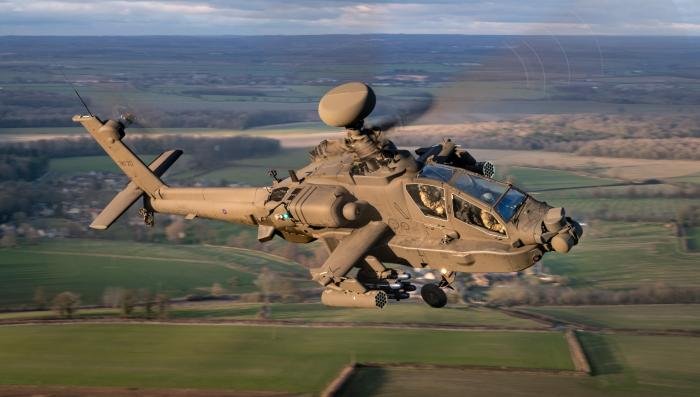
The AH-64E is being fielded into service by 3 Regiment Army Air Corps, a former operator of the Apache AH1, and 7 Aviation Support Battalion Royal Mechanical and Electrical Engineers (REME). The 7 Aviation Support Battalion occupies an impressive engineering facility, both in terms of scale and complexity, at Wattisham Airfield. Aviation supply unit 132 RLC works closely with the battalion and controls the AH1 force’s spare parts inventory – in addition, it is now taking responsibility for AH-64E spares. Although there are some parts commonalities between the two aircraft, 132 RLC must carefully maintain stocks as one platform is gradually withdrawn from service and the other ramps up.
The AH-64E is a new airframe with remanufactured components built by Boeing in the USA. Once prepared for air transportation, the complete and serviceable airframes are normally flown from Boeing via United States Air Force (USAF) C-5 Galaxy to RAF Mildenhall. Once they have arrived in the UK, the aircraft are then moved by road to Wattisham using the Joint Aircraft Recovery and Transportation Squadron (JARTS). On arrival, 7 Aviation Support Battalion’s Engineering Acceptance Team (EAT) begins a series of introduction-to-service tasks. The airframes first undergo rigorous delivery inspections, which identify any manufacturing defects prior to the reassembly process. Moreover, a full inventory of the airframe is conducted. Some equipment installed by Boeing in the USA is removed, inspected and reinstalled by the EAT. Typically, this consists of the blades, both tail and main rotor, along with the torque tube de-rotation unit, antennas and various other ancillaries.
Naturally, the re-installation of some of these components requires a significant amount of functional testing and maintenance operational checks. After engineering input, the aircraft are put in the hands of the army’s maintenance test pilots (MTPs). These experienced aircrew take the AH-64E through a full, rigorous regime of test profiles to provide engineering and aircrew confidence in speed, handling and avionic system integrity. During this testing phase, the MTPs seek to iron out any issues with the airframes so that when they transition to conduct regular line flying, they are in the best possible airworthiness state. This whole engineering acceptance process is strictly time controlled and has a direct effect on the UK’s attack helicopter defence capability for the fleet.
Whereas most military flying squadrons have integrated maintenance support personnel, the Army Air Corps calls on the REME for its engineering needs. In addition to the AH-64E acceptance process, the REME also provides all line and in-depth servicing to the entire fleet, with some assistance from civilian contractors.
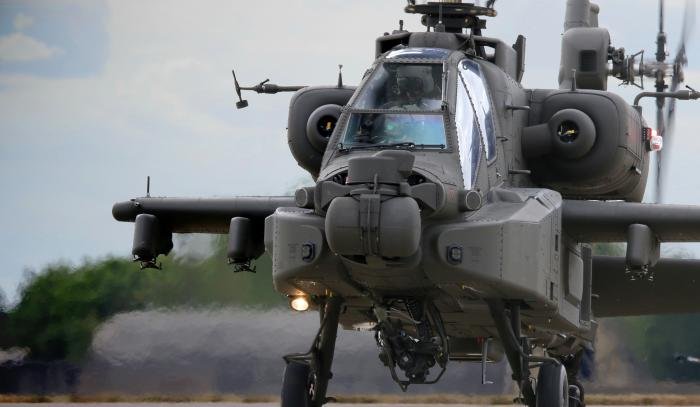
Captain ‘M’ (full name withheld) is an experienced Apache AH1 pilot, in the final stages of CTM (Conversion To Mark) training on the new AH-64E. He sat down with AFM to discuss the capabilities of Boeing’s latest-generation attack helicopter.
AH-64E
As the AH1 was a marked capability change for the AAC when it entered service in 2001, so too is the AH-64E. The aircraft’s design ethos centres on four pillars: to be survivable, agile, integrated and lethal.
SURVIVABILITY
The AH-64E brings with it many of the survivability and redundancy features found in the AH1 aircraft such as self-sealing fuel tanks, double and triple redundant flight systems and the ability to fly the aircraft from either crew position should one pilot be incapacitated. Pilots are surrounded by Kevlar plates designed to withstand 23mm projectiles and view the world through glass toughened to provide ballistic protection.
In the event of a crash landing, the chin-mounted M230 30mm gun is designed to ‘stroke in’ to a recess in the fuselage providing a flatter forward fuselage. Stub-wing mounted weapons pylons also shear-off during impact while crash-resistant seats protect crews at high rates of descent.
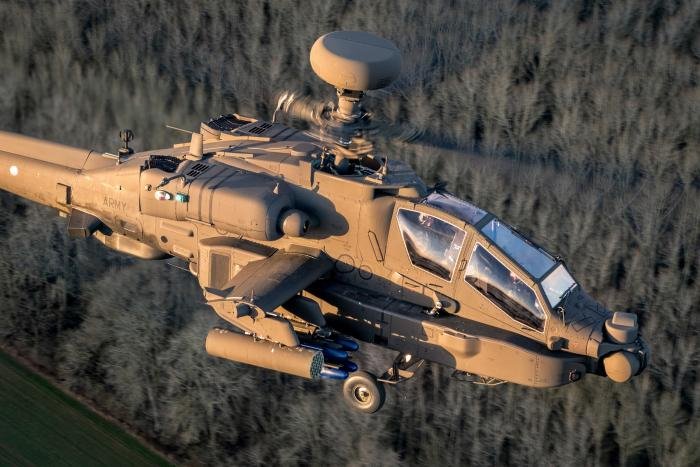
Capt ‘M’ said: “In addition to the elements ported over from the AH1, we now have a number of new systems to enhance our survivability.” The E-model is powered by two General Electric T700-701D turboshaft engines, in place of the AH1’s more powerful Rolls-Royce Turbomeca RTM322. While at first glance this may appear a step backwards, limitations with the AH1’s gearbox prevented full employment of the latter engine’s entire power range. An upgraded face gear transmission addresses this issue, giving access to more power, more of the time.
“One of the major advantages this brings is the ability to hover on a single engine, boosting crew confidence and allowing us to take the aircraft to new operating limits,” explained Capt ‘M’. The T700 is also notably smaller than the RTM322, giving engineers greater access for maintenance and servicing both in the hangar and in the field.
AGILITY
Even when operating with a full combat load, the AH-64 has remained an agile platform, something enhanced by the E-model’s reduced airframe weight and composite main rotor blades. “The increase in power and torque will enhance our ability to evade ground-based threats, too,” said ‘M’.
But AH-64E pilots will not just experience an improvement in the aircraft’s manoeuvrability: “The E-model provides crews with higher cognitive agility, too, thanks to the new CDAS (Cognitive Decision Aid System),” ‘M’ explained. Specific details of the CDAS’s full capabilities are classified, but the system will significantly reduce crew workload during the most demanding stages of missions. By scanning for incoming radar-emissions and comparing them with known sources, the software is able to identify potential threats and either provide a targeting solution or a navigation routing option, allowing crews to continue their missions while remaining outside a threat. CDAS can also take surrounding topographical features into account to offer terrain masking as part of any attack/evasion solution.
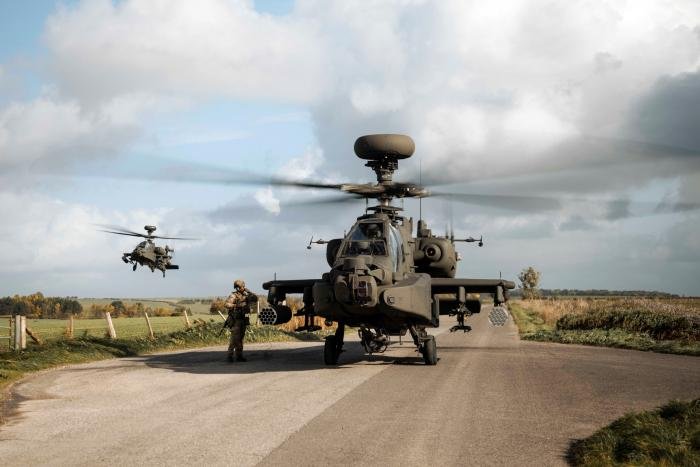
INTEGRATED
Connectivity is key to maintaining situational awareness on today’s battlefield, so to ensure the AH-64E is as combat-effective as possible it must seamlessly integrate into any wider NATO or allied force.
The Link-16 data link allows the secure transfer of imagery, voice and text communications between connected platforms in near real-time: “Link 16 will mean we can utilise data to a greater degree. While previously it was harder to share that data with everyone, we will now have a common operating picture while in the air,” said ‘M’.
Alongside transmitting and receiving data via Link-16, in time AH-64E crews will have access to the Rover data link derived system, MUM-T (Manned/Unmanned Teaming). This SATCOM (Satellite Communications) link will give pilots the ability to see and share real-time live feeds from unmanned platforms such as the RQ-7 Shadow and MQ-1C Gray Eagle.
Although not yet a confirmed role of the AAC’s AH-64E, the aircraft’s maritime attack capability has been significantly improved. The Longbow FCR (Fire Control Radar) has been upgraded allowing it to not only ‘see’ further (an increase in range from 8km vs 16km over land and sea), but also to identify different classes of ship when providing targeting and firing solutions.
Should the AH-64E operate in the maritime realm, it is envisaged it will do so while embarked on the Royal Navy’s two aircraft carriers as part of its Literal Response Groups (LRG). The aircraft would provide support and escort to embarked Royal Marines and support helicopters. The AH1 has already proven the value of embarked rotary-wing attack aviation, but this potent tool would wield new strength should it be combined with the F-35B and its suite of sensors.
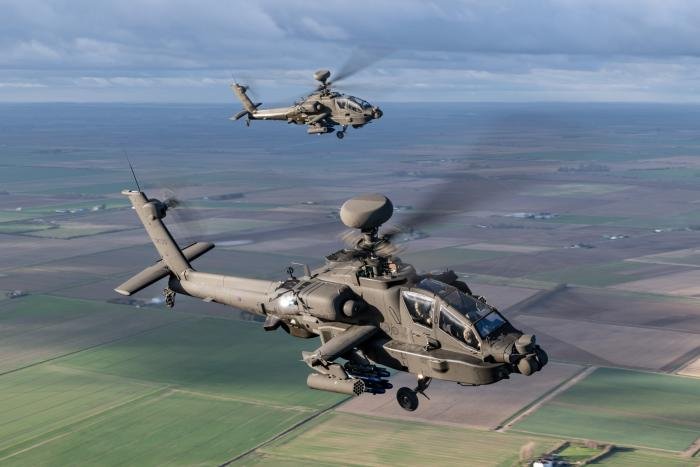
LETHAL
Of course, the Apache’s raison d’être is the effective delivery of highly accurate munitions. “We have received upgrades to all of our weapons systems bar the (M230) gun, but new processors will provide faster firing solutions,” said ‘M’.
The AH-64E will initially continue to use the AGM-114L Hellfire as its primary anti-armour weapon. A June 2021 announcement by UK Minister for Defence Procurement Jeremy Quinn confirmed the acquisition of the latest AGM-114R version and AGM-179 Joint Air-to-Ground Missile (JAGM). The ‘Romeo’ is set to replace all current versions of the Hellfire and, thanks to a multi-purpose warhead, can be employed against soft, armoured and embedded targets on land or at sea. This eliminates the need to carry multiple variants and further improves the aircraft’s potency.
The JAGM features dual-mode Semi-Active Laser (SAL) and millimetre wave (MMW) radar sensors offering a fire-and-forget capability. Manufacturer Lockheed Martin states that alongside stationary and moving land and maritime targets, the weapon can also prosecute airborne threats.
The seeker-head and guidance unit is mounted to the Hellfire’s body, motor and warhead preventing the need to modify the Apache’s existing missile rails. Procurement of the UK manufactured MBDA Brimstone was considered, but the JAGM was selected owing to its existing integration into the AH-64E and mission planning software.
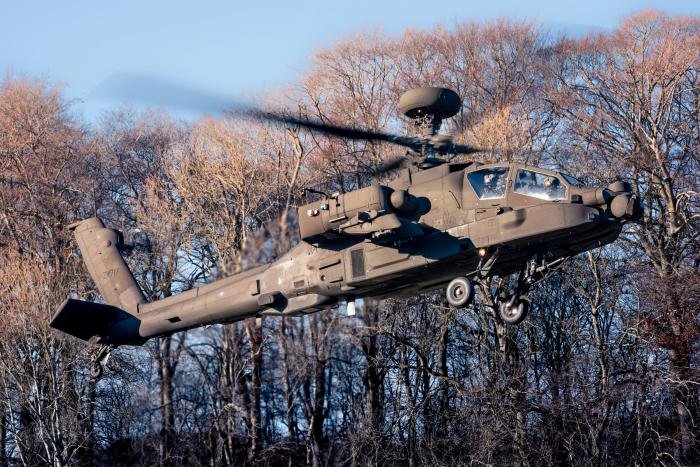
The final string to the AH-64E’s offensive bow is the Hydra 70 2.75-inch rocket. The weapon, similar in design to the CRV-7 rocket employed by the out-going Apache AH1 fleet, can be fitted with the AGR-20 APKWS (Advanced Precision Kill Weapon System), which transforms the unguided rocket into a precision-guided munition.
This will provide crews with a low-yield weapon option, reducing the likelihood of collateral damage: “APKWS will be a real game-changer for us. There are situations when Hellfire and 30mm are just too much, this will fill that gap,” said ‘M’.
The introduction of the platform has been relatively smooth: “We have had teething issues, but we have procedures in place to deal with them if they arise. It’s very rewarding that aircraft delivered six months ago we are now flying,” ‘M’ added.
Arriving during a turbulent period of defence spending, the AH-64E will form the backbone of the UK’s rotary-wing fires support for at least the next two decades. Capt ‘M’ said: “One of the main projects identified as of high importance to UK defence in the 2021 Integrated Review was the E-model. It is now a requirement for what we do to have a world-class attack helicopter.”
3 REGIMENT
One of the British Army’s two attack helicopter units, 3 Regiment is tasked with inducting the AH-64E into service and building an initial cadre of combat-ready pilots. The regiment is also developing new and adapting existing tactics to ensure the platform performs to its maximum potential.

During the run-up to Christmas 2022 the regiment’s focus was on ensuring its flying squadrons, 662 and 663, received sufficient training prior to declaring combat readiness later this year. Captain ‘M’ (full name withheld) told AFM: “We conducted low to medium intensity exercises towards the end of last year, such as Exercises Talon Guardian and Olethrion Eye [a reference to 662 Squadron’s motto “Olethrion Omma” or “death dealing eye”].”
The regiment’s third squadron is 669, which provides a range of support functions including: motor transport (MT), the training wing, command troop (a centralised hub of signals specialists who manage all manner of signals equipment and vehicles) and the deployable logistic framework. Additionally, the regiment has a workshop squadron that manages the REME engineers who conduct daily maintenance of the aircraft.
Exercise Talon Guardian in October 2022 marked the AH-64E’s exercise debut and saw 3 Regiment practising the mission sets it will be expected to fulfil when holding readiness. Aircraft first deployed from Wattisham Flying Station to Otterburn Ranges in Northumberland. Crews were called on to locate and simulate engaging enemy vehicles and were tested against simulated surface-to-air threats at RAF Spadeadam, Cumbria.
From Otterburn the regiment flew south to Sailsbury Plain Training Area, the UK Ministry of Defence’s 150 square mile exercise ground in Wiltshire. Here, Apaches hunted and simulated engaging Challenger 2 main battle tanks of the King’s Royal Hussars (KRH). These missions were mutually beneficial with Apache crews employing terrain masking to hide their approaches while the KRH used that same terrain to hide from the aircraft’s sensors and optics. Quite the game of cat and mouse.
Operating low-level over the battlefield exposes attack helicopters to both SAMs (surface to air missiles) and MANPADS (Man-portable air defence systems) and the Apache is no exception. To prepare for this, the regiment was pitted against 12 Regiment, Royal Artillery and its Stormer self-propelled Starstreak air defence systems.
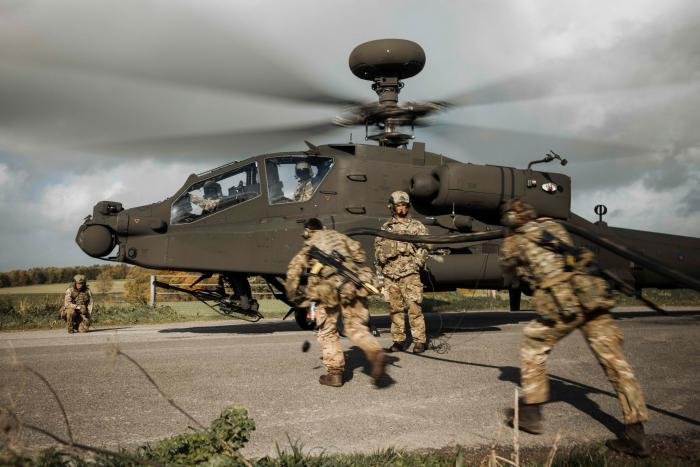
Members of the regiment have been conducting international exchange programmes with the United States Army. After completing their flying training at RAF Shawbury, Shropshire, selected students then travel to Fort Rucker, Alabama, to begin flying the Apache. In return, experienced US test pilots have been posted to Wattisham to help bring the aircraft into service. This, along with the decision to procure an ‘off-the-shelf’ variant of the Apache (the AH1 received a number of UK specific modifications requiring additional integration and cost) should see this new capability brought online in almost record time.
No 662 Squadron was declared fully qualified on type during exercise Wessex Storm in May; 663 Squadron should follow suit in August and conduct a validation exercise in September. No 663 participated in a three-week exercise in Scotland earlier this year, during which crews practised mountain flying and deep strike missions.
With both squadrons set to be operational by year-end, this paves the way for overseas deployments and exercises, Capt ‘M’ said: “Oman and Germany are certainly on the agenda for us and exercising in the Baltics is quite likely.” Indeed, the regiment is scheduled to participate in Ex Pinion Oman as part of the deployment of an Armoured Task Force in October 2023.
‘M’ was keen to point out none of the regiment’s output (nor of their sister unit, 4 Regiment) would be possible without a team effort: “There are two people in the cockpit, but a huge number of people who come together to make that happen. So many people make that 30mm round fire at Holbeach range.”
Recent events in Ukraine have raised questions about the vulnerability of attack helicopters. Numerous Russian helicopters have been lost to MANPADS since the invasion in 2022, including Ka-52s and Mi-28s – Russia’s answer to the Apache. However, the British Army’s confidence in the E is clear. The project remains a crucial investment for the defence ministry (MOD) and has the potential to be a star example of defence procurement. Due to commercial sensitivities, the MOD was unable to provide a unit price per aircraft. However, an MOD spokesperson said: “The Attack Helicopter Capability Sustainment Programme is currently delivering under budget and on schedule.”
Regardless of how the situation in Ukraine develops, the AH-64 is set to remain at the forefront of British attack aviation, only more survivable, agile, integrated and lethal.

